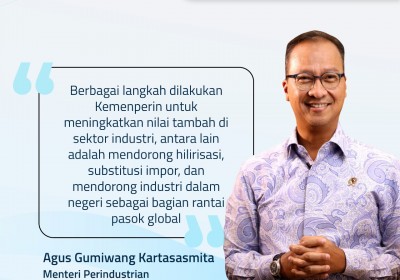Government Rolls Out Strategic Policies to Support Industrial Sector’s Performance
October 29, 2021
JAKARTA – In order to foster a conducive and fair business climate, the government has rolled out various strategic plans and policies that aim to support the pace and performance of the industrial sector.
One of the prime examples of these policies include the implementation of the 35% import substitution program, which is slated for 2022. This strategic effort is to reduce dependence on imported products while at the same time encouraging the strengthening of the domestic manufacturing industry’s structure.
“This strategy is taken in order to stimulate investment growth in the import substitution industrial sector and increase the utility of the domestic industry,” Industry Minister (Menperin) Agus Gumiwang Kartasasmita said in a press statement on Thursday (7/10). This policy will be supported by optimizing programs aimed to increase and encourage the use of domestically-made products.
Minister Agus noted that, based on the Making Indonesia 4.0 roadmap, there were initially 5 sectors that were considered as ‘development priorities’ which would lead the economy’s readiness to enter the Industry 4.0 era. However, due to the Covid-19 pandemic, the Industry Ministry (Kemenperin) added two more sectors to the list.
“The total number of sectors brings us to 7, which are: food & beverage, textiles & clothing, automotive, electronics, chemical, medical equipment and pharmaceutical products,” said the Minister. His goal for developing these 7 sectors is to ensure Indonesia’s place in the global market as one of the 10 largest economies in the world by 2030.
Minister Agus stressed that the set target is realistic enough to be achieved in this timeframe. Moreover, the achievement of current import substitution efforts, according to a number of directorates overseeing these sectors, are also considered to be on the right track towards achieving the target as well.
“We will continue to monitor and evaluate the achievement of this import substitution, because all sectors have been given their respective targets. Afterwards, we will look for solutions to some of the obstacles encountered. If this program can be achieved according to the quantitative target, we are optimistic that the industrial growth target of 5% to 5.5% next year can be achieved,” he explained.
The contribution of the non-oil and gas manufacturing sector to the national GDP in the second quarter of 2021 was at 17.34%, and the 5 largest contributors to the industrial sector to the national GDP are the food & beverage, chemical, pharmaceutical, metal goods, computers & electronic goods, optical & electrical equipment, transportation equipment and textile & clothing industries.
Meanwhile, data from the World Bank shows that throughout 2020, when the Covid-19 pandemic began to spread globally, Indonesia was still able to maintain its status as an industrial manufacturing-based country with sector contributions (oil & gas and non-oil & gas) to the national gross domestic product (GDP) exceeding 18%.
“Various steps have been taken by the Kemenperin to increase added value in the industrial sector, including encouraging downstreaming efforts, import substitution, and encouraging domestic industries to become part of the global supply chain,” Minister Agus noted.
The results are reflected in the strength of Indonesia’s manufacturing value added (MVA) day, which reached US$281 billion: the highest compared to other ASEAN countries.
Indonesia’s Research Institutions Supporting the Development of the Electric Vehicle Industry
Indonesian Muslim Fashion and Cosmetics IKMs Shine at Dubai World Expo 2020
Govt Steps Up UMKM Transformation Efforts in the Midst of Pandemic Slowdown
Govt Encourages Promotion of IKM Products in Digital Era
Government Begins Developing Maritime Training Center in Makassar
Tweets by IDDevForum
